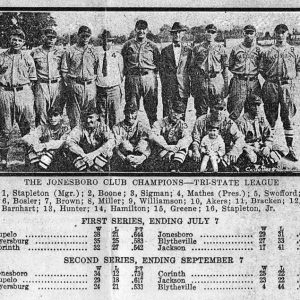calsfoundation@cals.org
Tri-State League
The Class D Tri-State League was established in 1925 and comprised teams in Arkansas, Mississippi, and Tennessee. In 1926, the league expanded into a fourth state, when Alabama’s Sheffield-Tuscumbia franchise joined the league. The National Association of Professional Baseball Leagues (NAPBL), the administrative agency of minor league baseball from 1901 to the present, sanctioned the league. At the time, the NAPBL’s classification structure ranged from Class A to D, with Class D being the lowest level of competition in professional baseball.
Memphis, Tennessee, attorney John D. Martin was the league’s president for both seasons of its existence. Martin was an established minor league baseball executive and president of the Class A Southern League. The goal of the league was to develop ballplayers, enabling them to climb the ranks of professional baseball.
The development of a player could be beneficial for both the player and his franchise. For example, Arkansas’s Jonesboro Buffaloes sold one of their standout players from the 1925 campaign to a Class D franchise in Jackson, Mississippi, for $1,000—sum that could cover a team’s payroll for nearly two months. The league attracted talented players from around the nation.
In 1925, the league provided its fans with a competitive pennant race and a high level of play on the field. The league generally enjoyed both fan support and financial stability, and only the Dyersburg, Tennessee, franchise failed to return in 1926. That year, however, attendance fell across the league, and by late June, many franchises struggled to stay in business.
On July 3, 1926, the league’s owners met in Memphis and voted to suspend the regular season on July 5. They were confident, however, that their troubles could be resolved. They vowed to return in 1927 and, as a demonstration of their optimism, scheduled a playoff series between the league’s top two clubs to be played immediately.
After splitting a double header with Arkansas’s Blytheville Tigers on July 5, the Jonesboro Buffaloes and Mississippi’s Corinth Corinthians stood tied for first place in the standings. The stage was set for the Buffaloes to meet the Corinthians in the championship series. Before taking on Corinth, however, the Jonesboro club accused the Corinth franchise of bringing in non-league players to bolster their line-up. After the charge was verified, turmoil ensued. Accusations of “bad sportsmanship” rang out in the local press. In response, Tri-State League president Martin canceled the series. Martin’s decision sealed the fate of the league.
The games played on July 5, 1926, were the last games played under the Tri-State League banner. Although its tenure on the professional baseball landscape was brief, the league did provide its fans with a number of fine individual performances and compelling story lines to follow. In order to maintain fan interest and a competitive pennant race, the league employed a split-season playoff format. In this format, the club with the best win-loss record in the first half of the season met the club with the best win-loss record in the second half of the season in a championship play-off series. If the same club won both halves, it was automatically declared league champion.
In the second half of the 1925 season, the two Arkansas entries, Jonesboro and Blytheville, were a classic study in contrasts. After grinding through the first half of the season, Jonesboro had won just twenty-nine of their first sixty games. They were just two games ahead of Blytheville. The second half of the season offered both clubs, then respectively fourth and fifth in the standings, a chance to start anew. The winner of the second half qualified to compete with the Tupelo Wolves, the first half winners, for the league title.
Blytheville experienced a collapse of epic proportion in the second half. Managing only four wins in forty-eight games, the team saw any hope of a second-half comeback evaporate. On the other hand, the Jonesboro Buffaloes outpaced the rest of the league by winning thirty-four of forty-six games. In the series final, the Wolves matched up well against the upstart Buffaloes. Jonesboro, however, was able to take a 3–2 series lead in the first five games of their best of seven series. In the sixth game, Jonesboro provided a balanced attack of fine pitching and timely hitting to take the league title.
The final curtain fell on the Tri-State League in July 1926 when it failed to capitalize on the momentum it had generated in 1925. In terms of its goal to prepare players to move up in the ranks of professional baseball, however, the league was a resounding success. Twelve of the league’s alumni played in the major leagues. These included future major league veterans Ben Cantwell, Sammy “Babe Ruth’s Legs” Byrd, Horace “Hod” Lisenbee, and Buckville (Garland County) native Silas “Al” Williamson.
|
Teams
|
Years of Participation
|
| Blytheville Tigers (Arkansas) | 1925–1926 |
| Corinth Corinthians (Mississippi) | 1925–1926 |
| Dyersburg Deers (Tennessee) | 1925 |
| Jackson Giants/Jays (Tennessee) | 1925–1926 |
| Jonesboro Buffaloes (Arkansas) | 1925–1926 |
| Sheffield-Tuscumbia Twins (Alabama) | 1926 |
| Tupelo Wolves (Mississippi) | 1925–1926 |
For additional information:
“Corinth’s Bad Spirit Causes Pres. Martin to Stop Series Plans.” Jonesboro Evening Sun. July 6, 1926, p. 3.
Edwards, Paul. “Farmers and Fastballs: The Culture of Baseball in Depression Era Northeast Arkansas.” Arkansas Review: A Journal of Delta Studies 41 (August 2010): 109–122.
“Hard Hitting Buff Outfielder Brings Thousand Dollars.” Jonesboro Evening Sun. April 28, 1926, p. 3.
Johnson, Lloyd, and Miles Wolff, eds. Encyclopedia of Minor League Baseball. 3rd ed. Durham, NC: Baseball America, 2007.
“Jonesboro Enters Tri-State League, Martin President.” Jonesboro Evening Sun. March 20, 1925, p.1.
Spaulding Official Base Ball Guide. 1926 and 1927 editions. Chicago: A. G. Spalding & Bros., 1926, 1927.
Paul Edwards
Boston, Massachusetts
 Recreation and Sports
Recreation and Sports Jonesboro Buffaloes
Jonesboro Buffaloes 




Comments
No comments on this entry yet.